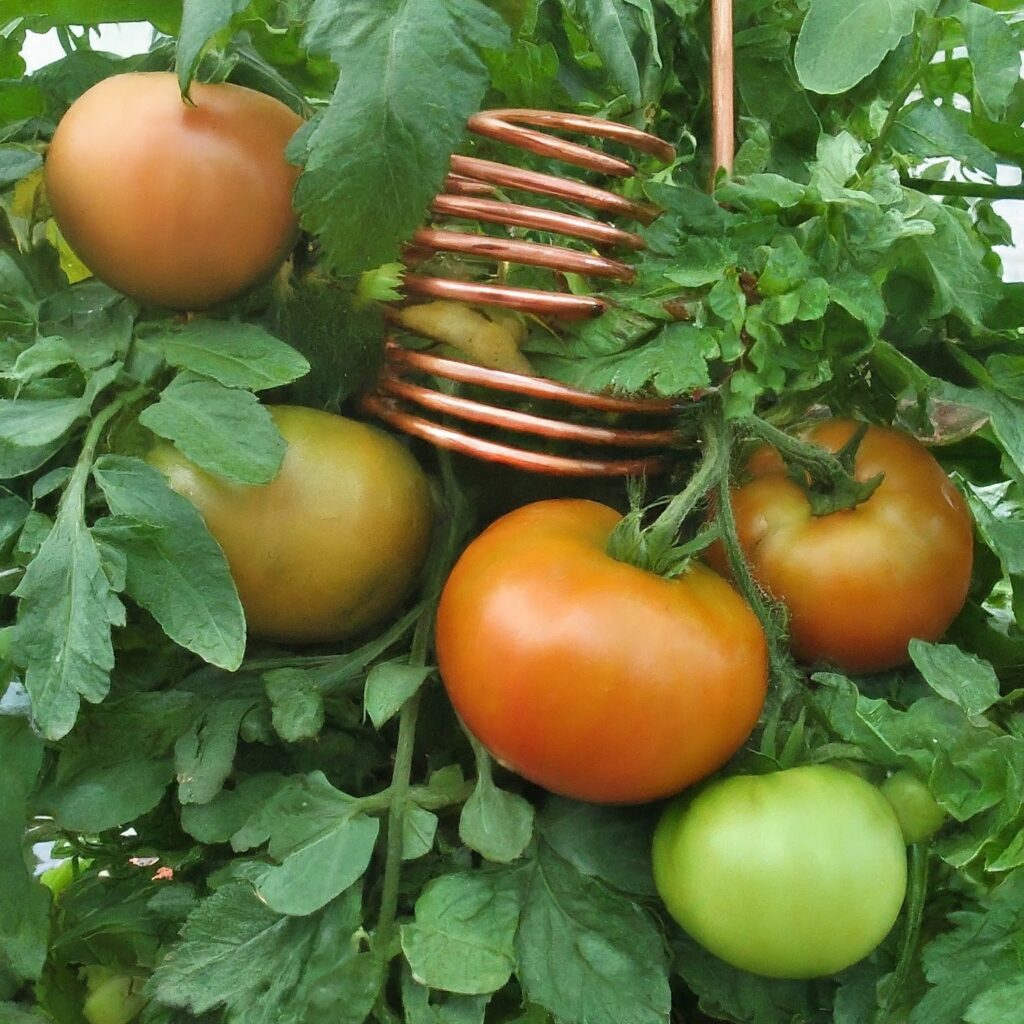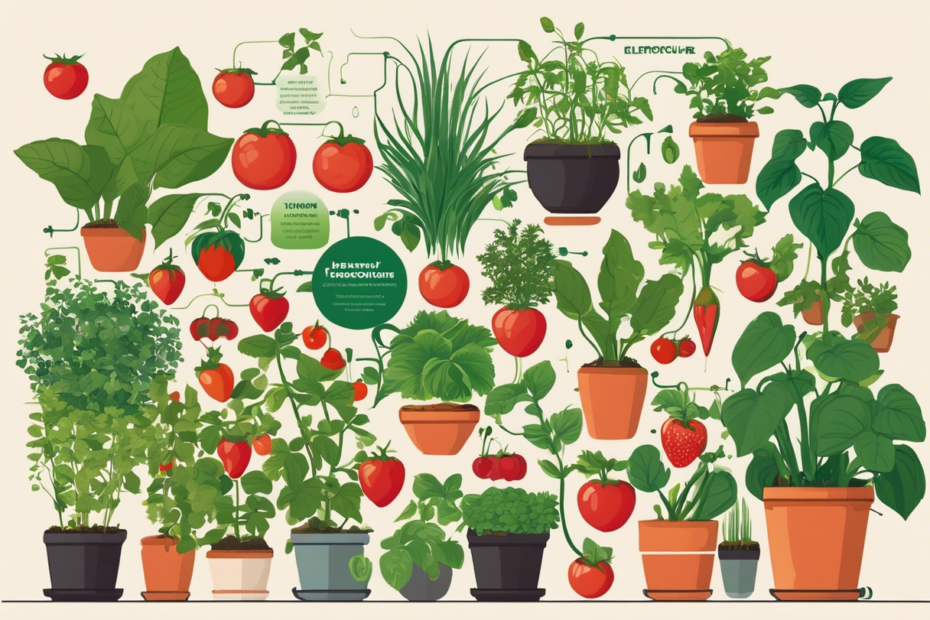Electroculture is a cutting-edge agricultural technique that involves the application of low-level electrical currents to plants or soil. The practice has gained popularity in recent years due to its potential to enhance plant growth, improve crop yields, and reduce the need for chemical fertilizers. By stimulating the plants’ natural processes, electroculture helps to boost nutrient uptake, increase photosynthesis, and promote overall plant health.
Electricity is known to have a stimulating effect on plant cells, encouraging them to absorb nutrients more efficiently and grow at an accelerated rate. Additionally, the application of electrical currents can help to repel pests and diseases, making electroculture an environmentally friendly and sustainable approach to farming.
One of the key benefits of electroculture is its versatility – it can be implemented in various settings, including large-scale agricultural operations, community gardens, and even indoor plant cultivation. As more research is conducted on the benefits of electroculture, farmers and gardeners are increasingly turning to this innovative method to improve their crop production.
In the following sections, we will explore the top 10 plants that can thrive using electroculture, highlighting the specific benefits of this technique for each plant species. By harnessing the power of electricity, growers can unlock the full potential of their plants and enjoy healthier, more abundant harvests.

How Electroculture Works
Electroculture involves the application of low-level electrical currents to plants to stimulate growth and improve overall plant health. Here is how electroculture works:
- Stimulation of Root Growth: The electrical currents applied to the soil enhance root development by activating the ion exchange process, which facilitates the absorption of nutrients by the roots.
- Increased Nutrient Uptake: Electroculture helps in increasing the availability of nutrients in the soil, making it easier for plants to absorb essential minerals like nitrogen, phosphorus, and potassium.
- Enhanced Photosynthesis: The electrical stimulation provided to plants triggers an increase in chlorophyll production, which, in turn, enhances the photosynthesis process. This leads to improved growth rates and higher yields.
- Improved Water Absorption: By stimulating the roots, electroculture improves the plant’s ability to uptake water efficiently. This is especially beneficial during dry periods or in areas with limited water supply.
- Pest Control: Some studies suggest that electroculture can also help in deterring pests and diseases, as the electrical currents create an unfavorable environment for certain pests to thrive.
- Environmental Benefits: Electroculture is considered an environmentally friendly practice as it reduces the need for chemical fertilizers and pesticides, leading to a more sustainable and organic approach to cultivation.
In summary, electroculture harnesses the power of electricity to enhance plant growth, nutrient uptake, and overall health, offering a promising alternative for sustainable agriculture practices. Benefits of Using Electroculture
- Increased Plant Growth: Electroculture technology has been shown to stimulate plant growth, resulting in healthier and more robust plants.
- Improved Nutrient Absorption: By using electroculture, plants can better absorb nutrients from the soil, leading to enhanced growth and development.
- Reduced Pest Damage: Studies have suggested that electroculture can help repel pests, reducing the need for chemical pesticides.
- Water Conservation: Electroculture has the potential to improve water retention in the soil, reducing the amount of water needed for plant growth.
- Enhanced Soil Health: The use of electroculture can promote microbial activity in the soil, contributing to overall soil health and fertility.
- Energy-Efficient: Electroculture systems are relatively energy-efficient compared to traditional farming methods, making them a more sustainable option.
- Cost-Effective: In the long run, electroculture can be cost-effective as it may reduce the need for fertilizers and pesticides.
- Environmental Benefits: By promoting healthier plant growth and reducing the use of harmful chemicals, electroculture can have positive environmental impacts.
Incorporating electroculture into your gardening or farming practices can offer a range of benefits that contribute to more sustainable and efficient plant growth.
Choosing the Right Plants for Electroculture
When selecting plants for electroculture, it is essential to choose species that are known to respond well to electrical stimulation. Some factors to consider when choosing the right plants for electroculture include:
- Plant Type: Certain plants, such as herbs, vegetables, and some fruiting plants, tend to show better responses to electroculture techniques compared to others.
- Response to Electrical Stimulation: Plants that are known to be more sensitive or responsive to electrical stimulation, such as increased growth rates or enhanced nutrient uptake, are ideal candidates for electroculture.
- Adaptability: Opt for plants that are adaptable to different growing conditions and can thrive in the electrocultured environment.
- Environmental Conditions: Consider the climate and environmental factors in your region to ensure that the selected plants can grow successfully with electroculture methods.
- Research: Look for plants that have been studied or have documented cases of successful growth with electroculture to increase the likelihood of a positive outcome.
Some common plants that have shown positive responses to electroculture techniques include tomatoes, peppers, strawberries, and lettuce. These plants have exhibited enhanced growth, increased yields, and improved nutrient absorption when subjected to controlled electrical stimulus. By choosing the right plants for electroculture based on these factors, growers can maximize the benefits of this innovative cultivation method.
Top 10 Plants for Electroculture
- Tomatoes
- Tomatoes are known to respond well to electroculture techniques, resulting in increased fruit production and improved flavor.
- Peppers
- Peppers thrive when grown using electroculture, with larger fruits and increased resistance to diseases.
- Lettuce
- Lettuce plants benefit from electroculture by growing faster and producing more abundant and crisp leaves.
- Cucumbers
- Cucumbers grown with electroculture methods tend to be more robust and have a higher yield compared to traditional methods.
- Strawberries
- Electro-stimulated strawberries often show enhanced sweetness and a longer shelf life, making them a favorite for electroculture enthusiasts.
- Beans
- Beans respond positively to electroculture, resulting in higher bean production and better disease resistance.
- Corn
- Corn plants show improved growth and higher yields when electroculture techniques are applied during cultivation.
- Herbs (such as basil and mint)
- Herbs grown using electroculture methods exhibit stronger flavors, increased fragrance, and faster growth cycles.
- Squash
- Squash plants benefit from electroculture by producing more uniform fruits and showing increased resistance to pests and diseases.
- Cabbage
- Electro-stimulated cabbage plants often have denser heads and enhanced nutrient content, making them a popular choice for electroculture gardening.
These top 10 plants showcase the benefits of using electroculture techniques in plant cultivation, leading to healthier, more productive yields with improved flavor and resistance to diseases.

1. Tomatoes
Tomatoes are a popular choice for growers using electroculture due to their sensitivity to environmental stimuli. The application of electrical signals can enhance the growth, yield, and quality of tomatoes. Here are some key points to consider when growing tomatoes with electroculture:
- Enhanced nutrient uptake: Electrostimulation can improve the uptake of essential nutrients by tomato plants, leading to healthier and more robust growth.
- Increased fruit production: The use of electric currents has been shown to stimulate flower production in tomatoes, resulting in higher yields of delicious, ripe fruit.
- Pest and disease resistance: Electroculture can help boost the natural defense mechanisms of tomato plants, making them more resistant to pests and diseases.
- Faster growth: Electrical stimulation has been found to accelerate the growth rate of tomatoes, allowing for quicker harvest times and increased overall productivity.
Incorporating electroculture techniques into tomato cultivation can lead to significant improvements in plant health, yield, and quality. By providing the right electrical signals, growers can effectively optimize the growth conditions for their tomato plants, resulting in bountiful harvests of flavorful, juicy tomatoes.
2. Peppers
Peppers are a popular crop for many home gardeners due to their versatility in cooking and vibrant colors. When using electroculture to grow peppers, there are several benefits to consider. Electro-stimulated peppers often exhibit increased growth rates and improved fruit quality, making them an excellent choice for this innovative method of cultivation.
Advantages of using electroculture for growing peppers:
- Increased Yield: Electro-stimulation has been shown to enhance the yield of pepper plants, leading to a higher production of peppers per plant.
- Accelerated Growth: By applying controlled electrical currents to the plants, their growth is accelerated, resulting in quicker maturation of peppers.
- Pest Resistance: Electro-stimulated plants tend to develop stronger immune systems, making them more resistant to pests and diseases.
- Nutrient Absorption: Electroculture can improve the plant’s ability to absorb essential nutrients from the soil, leading to healthier and more robust pepper plants.
How to apply electroculture techniques to pepper plants:
- Electrodes Placement: Place the electrodes strategically around the pepper plants to ensure even electrical stimulation.
- Controlled Current: Monitor and adjust the electrical current to a level that is optimal for the pepper plants’ growth without causing damage.
- Regular Monitoring: Check the plants regularly for any signs of stress or overstimulation, and make adjustments as needed.
- Combine with Traditional Methods: Electroculture can be used in conjunction with traditional farming practices to maximize the benefits for the pepper plants.
By incorporating electroculture techniques into the cultivation of pepper plants, gardeners can enjoy higher yields, improved plant health, and overall better quality peppers for cooking and consumption.
3. Lettuce
Lettuce is a popular choice for many gardeners due to its versatility and rapid growth. When using electroculture to cultivate lettuce, there are a few key points to keep in mind:
- Seed Germination: By exposing lettuce seeds to a low-voltage electric field, you can potentially enhance germination rates and promote quicker seedling development.
- Nutrient Absorption: Electroculture can help improve the absorption of nutrients by lettuce plants, leading to healthier and more vibrant growth.
- Water Efficiency: Through electroculture, lettuce plants may become more efficient in utilizing water, reducing water consumption while maintaining optimal hydration levels.
- Pest Resistance: Some studies suggest that electroculture can enhance the natural resistance of lettuce plants to certain pests and diseases, reducing the need for chemical interventions.
- Yield and Quality: Electrocultivated lettuce may show improved yields and overall quality, with potential benefits for both home gardeners and commercial producers.
Incorporating electroculture techniques into the cultivation of lettuce can be a rewarding experience, offering the opportunity to grow healthier, more resilient plants while potentially increasing yields. By experimenting with electroculture on lettuce, gardeners may discover innovative ways to optimize their growing methods and produce bountiful harvests of this popular leafy green.
4. Cucumbers
Cucumbers are a popular addition to many gardens due to their versatility and refreshing taste. When grown using electroculture, cucumbers can benefit significantly from the enhanced nutrient absorption and growth stimulation provided by the technology.

- Nutrient Absorption: Electro culture can help cucumbers absorb essential nutrients more efficiently, leading to healthier and more robust plants. The electric currents stimulate the roots, allowing them to take up nutrients more effectively from the soil.
- Increased Yield: By promoting root growth and nutrient uptake, electroculture can contribute to higher cucumber yields. This means more cucumbers for you to enjoy throughout the growing season.
- Faster Growth: The stimulation of plant growth through electroculture can result in quicker development of cucumber plants. This can be especially beneficial if you are looking to harvest cucumbers earlier or to have multiple harvests in a season.
- Resistance to Pests and Diseases: Some studies suggest that electroculture-treated plants may have increased resistance to pests and diseases. This can be advantageous when cultivating cucumbers, as they are vulnerable to certain pests and fungal infections.
- Improved Flavor: The enhanced nutrient absorption and accelerated growth provided by electroculture may also lead to cucumbers with improved flavor. You can expect crispier, more flavorful cucumbers when using this innovative technology.
Overall, growing cucumbers using electroculture can result in healthier plants, increased yields, and improved flavor, making it a promising method for cucumber cultivation in your garden.
5. Strawberries
Strawberries are a popular and delicious fruit that can be easily grown using electroculture techniques. By applying controlled electrical currents to the soil, strawberry plants can benefit from increased growth and productivity. Here are some key points to consider when growing strawberries with electroculture:
- Increased Yield: Electroculture has been shown to enhance the yield of strawberry plants by promoting better nutrient absorption and root development.
- Improved Taste: With electroculture, strawberries often have a sweeter flavor due to the increased uptake of essential nutrients.
- Disease Resistance: The controlled electrical currents can help boost the immune system of the strawberry plants, making them more resistant to common diseases and pests.
- Faster Growth: Electroculture can accelerate the growth rate of strawberry plants, leading to earlier harvests and a longer fruiting period.
- Environmental Benefits: By using electroculture to grow strawberries, farmers can reduce the need for chemical fertilizers and pesticides, creating a more environmentally friendly growing method.
- Cost-Effective: While there may be initial setup costs for electroculture equipment, the long-term benefits of increased yields and reduced need for chemical inputs can make it a cost-effective choice for strawberry growers.
Overall, using electroculture to grow strawberries can result in healthier plants, higher yields, and better-tasting fruit while also being more sustainable and cost-effective in the long run.
6. Eggplants
Eggplants, also known as aubergines, are versatile plants that thrive well with electroculture methods due to their need for consistent moisture levels and nutrients. By applying electroculture techniques, such as stimulating root growth and nutrient absorption, gardeners can enhance the productivity and health of eggplants.
- Eggplants benefit from the increased uptake of essential nutrients, leading to better fruit development and overall plant growth.
- Electroculture can help in improving the resistance of eggplants to pests and diseases, reducing the need for chemical pesticides.
- By promoting better root development, electroculture enables eggplants to establish stronger and more extensive root systems, which can lead to enhanced water and nutrient absorption.
Furthermore, the electromagnetic stimulation provided by electroculture can aid in seed germination and overall plant vitality. The consistent application of electrical currents can result in more robust eggplant plants with higher yields.
Incorporating electroculture techniques into the cultivation of eggplants can lead to healthier plants, increased yields, and a more sustainable gardening approach.
7. Spinach
Spinach is a versatile and nutritious leafy green that thrives when grown using electroculture techniques. Electro stimulation can enhance the growth and overall health of spinach plants by promoting nutrient absorption and photosynthesis. Here are some key points to consider when growing spinach with electroculture:
- Increased Nutrient Absorption: Electroculture can help spinach plants to absorb essential nutrients more efficiently from the soil, leading to healthier and more robust growth.
- Faster Growth Rate: The application of electrical currents can stimulate the growth processes in spinach plants, resulting in quicker development and higher yields.
- Resistance to Pests and Diseases: Electro stimulation has been shown to improve the natural defenses of spinach plants, making them more resistant to common pests and diseases.
- Enhanced Flavor and Nutritional Value: Spinach grown using electroculture techniques may have a richer flavor profile and higher nutritional content due to improved nutrient uptake.
- Sustainable Growing Method: Electroculture is an environmentally friendly growing method that can reduce the need for chemical fertilizers and pesticides, making it a sustainable option for cultivating spinach.
- Adaptability to Various Environments: Spinach plants grown with electro stimulation have shown increased adaptability to different environmental conditions, making them suitable for a wide range of climates.
Incorporating electroculture techniques into the cultivation of spinach can result in healthier plants, higher yields, and a more sustainable growing process. By harnessing the power of electrical currents, growers can optimize the growth and development of spinach plants while reducing the reliance on conventional agricultural inputs.
8. Kale
Kale is a nutrient-dense leafy green that thrives with the use of electroculture. It is a robust plant that responds well to the stimulation of electrical currents in the soil. By incorporating electroculture techniques, kale plants experience improved nutrient uptake, leading to enhanced growth and development.
Benefits of growing kale with electroculture:
- Increased nutrient absorption: Electroculture helps kale plants absorb essential nutrients more efficiently from the soil, resulting in healthier and more nutrient-rich leaves.
- Faster growth: The application of electrical currents accelerates the growth rate of kale plants, allowing for quicker harvests and continuous production throughout the season.
- Pest and disease resistance: Electroculture strengthens the natural defense mechanisms of kale plants, making them more resilient to pests and diseases.
- Enhanced flavor: Kale grown using electroculture techniques often exhibits a richer and more intense flavor profile, making it a preferred choice for culinary enthusiasts.
- Environmental sustainability: Electroculture promotes sustainable agricultural practices by reducing the need for chemical fertilizers and pesticides, making kale cultivation more eco-friendly.
When growing kale with electroculture, it is essential to monitor the electrical inputs carefully to ensure optimal plant growth. By harnessing the power of electrical stimulation, farmers and gardeners can cultivate kale that is not only visually appealing but also packed with essential nutrients and flavors.
9. Basil
Basil is a popular herb known for its aromatic leaves and culinary uses. When grown using electroculture, basil plants exhibit enhanced growth and vitality. The application of controlled electrical currents to the soil can promote better nutrient absorption and overall plant health, resulting in larger and healthier basil plants.
Some benefits of growing basil with electroculture include:
- Increased essential oil production: The use of electroculture can stimulate the production of essential oils in basil plants, enhancing their flavor and aroma.
- Improved resistance to pests and diseases: Electroculture has been shown to strengthen the immune system of plants, making basil less susceptible to pest infestations and diseases.
- Faster growth rates: Basil plants grown with electroculture methods tend to grow more quickly than those grown using traditional cultivation techniques.
To optimize the growth of basil using electroculture, it is recommended to apply low-voltage electrical currents to the soil regularly. Additionally, ensuring proper soil moisture levels and providing adequate sunlight are essential for the overall health and productivity of basil plants.
Whether grown in a garden, greenhouse, or indoor container, basil plants can benefit significantly from the use of electroculture techniques. By harnessing the power of electricity, growers can achieve robust and flourishing basil plants that not only enhance the aesthetics of their surroundings but also provide a fresh and flavorful addition to their culinary creations.
10. Mint
Mint is a versatile and popular herb that can thrive using electroculture. Here are some key points to consider when growing mint with this innovative method:
- Benefits: Mint grown with electroculture can exhibit increased growth rates, enhanced flavor, and improved resistance to pests and diseases.
- Soil Requirements: Mint prefers well-draining soil with a pH between 6.0 and 7.0. Electroculture can help optimize the soil conditions for mint growth.
- Watering: Mint plants require consistently moist soil. Electroculture can assist in better water absorption and utilization by the plants.
- Sunlight: Mint thrives in full sunlight but can also tolerate partial shade. Electroculture can potentially enhance the plant’s ability to harness sunlight for photosynthesis.
- Temperature: Mint grows best in moderate temperatures between 65°F to 70°F (18°C to 21°C). Electroculture may help regulate the temperature around the plant roots.
- Maintenance: Regular pruning is beneficial for mint plants. Electroculture can aid in stimulating growth and branching, leading to bushier and healthier mint plants.
- Harvesting: Mint leaves can be harvested throughout the growing season. Electroculture may contribute to an increase in the overall yield of mint leaves.
Incorporating electroculture techniques when growing mint can be a rewarding experience, resulting in robust, flavorful herbs that can elevate culinary dishes and provide aromatic teas.
Factors to Consider When Growing Plants with Electroculture
- Soil Type: Different soil types conduct electricity differently. Consider the soil composition on your property before implementing electroculture.
- Moisture Levels: The level of moisture in the soil affects its conductivity. Plants grown using electroculture require a certain level of moisture to enhance electrical conductivity.
- Plant Species: Not all plants respond the same way to electroculture. Research which plant species are most suitable for this cultivation method.
- Electricity Source: Ensure you have a reliable and safe electricity source for electroculture. Consider the voltage and frequency requirements for optimal plant growth.
- Electrode Placement: Proper placement of electrodes is crucial for successful electroculture. Position electrodes at the right depth and distance from plant roots.
- Monitoring: Regular monitoring of soil conductivity and plant growth is essential. Adjust the electroculture setup as needed based on plant response.
- Safety: Safety precautions must be taken when working with electricity in the garden. Familiarize yourself with electroculture safety guidelines.
- Environmental Impact: Consider the environmental impact of electroculture on the surrounding ecosystem. Minimize any potential negative effects.
- Cost: Evaluate the cost of setting up and maintaining an electroculture system. Factor in electricity costs and equipment expenses.
- Expert Consultation: If new to electroculture, consider consulting with experts in the field for guidance on best practices and techniques.
Each of these factors plays a crucial role in the success of growing plants using electroculture. By carefully considering these aspects, gardeners can maximize the benefits of this innovative cultivation method.
Setting Up an Electroculture System
Setting up an electroculture system may vary depending on the specific needs of the plants being grown. However, there are some general steps to follow when implementing this innovative method:
- Selecting the right plants: Begin by choosing plants that are known to respond well to electroculture, such as tomatoes, strawberries, or cucumbers.
- Choosing the appropriate electrodes: Decide on the type of electrodes to use based on the plant’s size and the area to be covered. Options include copper, zinc, or iron electrodes.
- Placement of electrodes: Position the electrodes strategically around the plants, ensuring they are buried deeply enough in the soil to reach the plant’s root system.
- Connecting the electrodes: Connect the electrodes to a low voltage, high-frequency power source. Ensure the system is set up correctly to provide a safe and effective electrical charge.
- Monitoring the system: Regularly check the electroculture system to ensure it is functioning correctly. Adjust the power source if necessary to maintain optimal conditions for plant growth.
- Observing plant growth: Keep a close eye on the plants to observe any changes in growth patterns or yield. Document any noticeable improvements resulting from the electroculture system.
By following these steps and closely monitoring the electroculture system, growers can potentially enhance plant growth, increase crop yields, and improve overall plant health.
The Ultimate ELECTROCULTURE Video Course
Tips for Successful Plant Growth with Electroculture
- Ensure proper placement of electrodes: Place the electrodes at a suitable distance from each other based on the plant type. This will help in delivering the right amount of electricity for optimal growth.
- Monitor electricity levels: Regularly check and adjust the electricity levels to prevent overstimulation of the plants. Different plants have varying requirements, so it’s essential to find the right balance.
- Use high-quality electrodes: Invest in good quality electrodes to ensure efficient conduction of electricity to the plants. Poor quality electrodes can lead to uneven distribution of electricity.
- Maintain consistent watering: Proper watering is crucial for plant growth, even with electroculture. Monitor soil moisture levels and adjust watering practices as needed to support healthy growth.
- Start with small currents: When starting with electroculture, begin with low electricity levels to allow plants to adjust gradually. Increase the intensity over time as the plants become accustomed to the treatment.
- Rotate electrode placement: To promote even growth, periodically rotate the placement of the electrodes around the plant. This can prevent overstimulation of specific areas and encourage balanced development.
- Keep an eye on plant health: Monitor the plants closely for any signs of stress or overstimulation. Adjust the electroculture settings if you notice any negative effects on plant health.
- Conduct regular soil tests: Test the soil for nutrients and pH levels to ensure that the plants are receiving adequate nutrition for optimal growth. Adjust fertilization practices as needed based on the test results.
- Seek expert advice: If you are new to electroculture or experiencing challenges with plant growth, don’t hesitate to seek advice from experts in the field. They can provide guidance tailored to your specific needs.
- Experiment and learn: Electro culture is a relatively new technique, so don’t be afraid to experiment with different settings and approaches. Learn from your experiences and adjust your methods to improve plant growth outcomes.
Common Mistakes to Avoid
- Overuse of electricity: Applying too much electricity can harm the plants rather than benefit them. It is essential to follow recommended guidelines to avoid overstimulating the plants.
- Incorrect placement of electrodes: Placing the electrodes too close to the plants can cause burns or damage. It is crucial to position the electrodes at the recommended distance to ensure optimal results.
- Neglecting soil health: Electroculture works best in fertile and well-drained soil. Neglecting soil health can impact the effectiveness of the method. Regularly testing and improving soil quality is important for successful plant growth.
- Ignoring plant requirements: Each plant has specific needs in terms of water, nutrients, and light. Failure to meet these requirements can hinder growth, regardless of the electroculture method used. It is important to research and understand the needs of each plant before applying electroculture techniques.
- Using poor quality electrodes: The electrodes are a crucial component of electroculture, and using inferior quality electrodes can lead to ineffective results. Investing in high-quality electrodes is necessary for optimal plant growth.
- Lack of monitoring: Monitoring the plants is essential when using electroculture. Changes in plant growth, color, or overall health should be observed and adjustments made accordingly. Regular monitoring ensures the method is working effectively.
- Not adjusting electricity levels: Plants may respond differently to varying levels of electricity. It is important to adjust the electricity levels based on the plant’s response to achieve the best results. Failure to do so may limit the benefits of electroculture.
Frequently Asked Questions about Electroculture
- What is electroculture? Electro culture is an experimental method of stimulating plant growth using electricity. It involves applying low levels of electric current to plants’ roots or leaves to enhance their development.
- Is electroculture safe for plants? Yes, electro culture is considered safe for plants when done correctly and in controlled conditions. Excessive electrical currents can harm plants, so it is essential to follow recommended guidelines.
- What are the benefits of using electroculture? Electro culture can stimulate plant growth, increase yields, improve soil quality, and potentially reduce the need for chemical fertilizers. It also has the potential to enhance nutrient uptake and plant resistance to diseases.
- Can electroculture be used for all types of plants? While electro culture has shown positive results across various plant species, certain plants may respond better to electrical stimulation than others. It is essential to research specific plants before implementing electroculture.
- How do I apply electroculture to my plants? Electro culture can be applied through various methods, such as applying electrodes to the soil, using foliar sprays, or incorporating electrodes into irrigation systems. It is crucial to follow instructions carefully to avoid damaging the plants.
- Is electroculture environmentally friendly? Electro culture has the potential to reduce the reliance on chemical fertilizers and pesticides, making it a more environmentally friendly approach to agriculture. However, the long-term effects of electroculture on the environment are still being studied.
- Are there any risks associated with electroculture? While electroculture is generally safe for plants, there may be risks associated with improper use of electricity or equipment malfunction. It is essential to follow safety guidelines and use reliable equipment to minimize these risks.
Conclusion
- Electroculture shows promising results in enhancing plant growth and yield by stimulating seed germination, root development, and nutrient absorption in various crops.
- Over the years, researchers and farmers have experimented with electroculture to improve agricultural practices and increase sustainability.
- By harnessing the power of electricity in a controlled manner, plants can benefit from increased growth rates and overall health.
- The top 10 plants to grow using electroculture have been identified based on research and successful outcomes in different settings.
- Each of the recommended plants, such as tomatoes, peppers, and strawberries, has shown improved growth and productivity when subjected to electroculture methods.
- While electroculture is a relatively new concept in agriculture, its potential to revolutionize farming practices is undeniable.
- Understanding the specific needs of each plant and tailoring the electroculture techniques accordingly can maximize the benefits for farmers and gardeners.
- As more studies are conducted and practical applications of electroculture are explored, the list of plants that can benefit from this technology is likely to expand.
- Incorporating electroculture into traditional farming methods has the potential to increase crop yields, improve soil health, and reduce the reliance on chemical fertilizers.
- The future of agriculture may very well be electrified, as electroculture continues to gain recognition for its role in sustainable and efficient plant growth practices.

